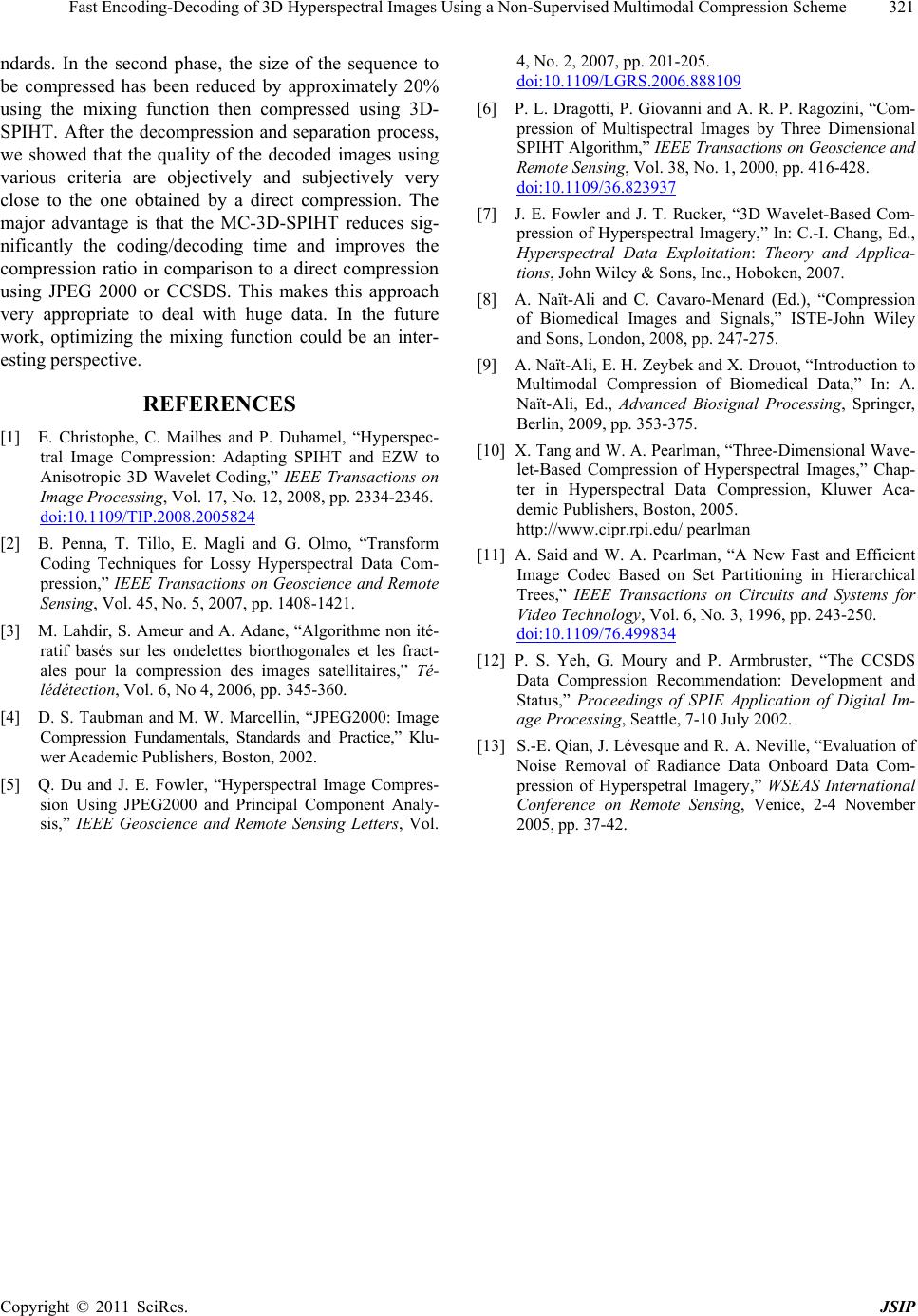
Fast Encoding-Decoding of 3D Hyperspectral Images Using a Non-Supervised Multimodal Compression Scheme
Copyright © 2011 SciRes. JSIP
321
ndards. In the second phase, the size of the sequence to
be compressed has been reduced by approximately 20%
using the mixing function then compressed using 3D-
SPIHT. After the decompression and separation process,
we showed that the quality of the decoded images using
various criteria are objectively and subjectively very
close to the one obtained by a direct compression. The
major advantage is that the MC-3D-SPIHT reduces sig-
nificantly the coding/decoding time and improves the
compression ratio in comparison to a direct compression
using JPEG 2000 or CCSDS. This makes this approach
very appropriate to deal with huge data. In the future
work, optimizing the mixing function could be an inter-
esting perspect ive .
REFERENCES
[1] E. Christophe, C. Mailhes and P. Duhamel, “Hyperspec-
tral Image Compression: Adapting SPIHT and EZW to
Anisotropic 3D Wavelet Coding,” IEEE Transactions on
Image Processing, Vol. 17, No. 12, 2008, pp. 2334-2346.
doi:10.1109/TIP.2008.2005824
[2] B. Penna, T. Tillo, E. Magli and G. Olmo, “Transform
Coding Techniques for Lossy Hyperspectral Data Com-
pression,” IEEE Transactions on Geoscience and Remote
Sensing, Vol. 45, No. 5, 2007, pp. 1408-1421.
[3] M. Lahdir, S. Ameur and A. Adane, “Algorithme non ité-
ratif basés sur les ondelettes biorthogonales et les fract-
ales pour la compression des images satellitaires,” Té-
lédétection, Vol. 6, No 4, 2006, pp. 345-360.
[4] D. S. Taubman and M. W. Marcellin, “JPEG2000: Image
Compression Fundamentals, Standards and Practice,” Klu-
we r Academic Publishers, Boston, 2002.
[5] Q. Du and J. E. Fowler, “Hyperspectral Image Compres-
sion Using JPEG2000 and Principal Component Analy-
sis,” IEEE Geoscience and Remote Sensing Letters, Vol.
4, No. 2, 2007, pp. 201-205.
doi:10.1109/LGRS.2006.888109
[6] P. L. Dragotti, P. Giovanni and A. R. P. Ragozini, “Com-
pression of Multispectral Images by Three Dimensional
SPIHT Algorithm,” IEEE Transactions on Geoscience and
Remote Sensing, Vol. 38, No. 1, 2000, pp. 416-428.
doi:10.1109/36.823937
[7] J. E. Fowler and J. T. Rucker, “3D Wavelet-Based Com-
pression of Hyperspectral Imagery,” In: C.-I. Chang, Ed.,
Hyperspectral Data Exploitation: Theory and Applica-
tions, John Wiley & Sons, Inc., Hoboken, 2007.
[8] A. Naït-Ali and C. Cavaro-Menard (Ed.), “Compression
of Biomedical Images and Signals,” ISTE-John Wiley
and Sons, London, 2008, pp. 247-275.
[9] A. Naït-Ali, E. H. Zeybek and X. Drouot, “Introduction to
Multimodal Compression of Biomedical Data,” In: A.
Naït-Ali, Ed., Advanced Biosignal Processing, Springer,
Berlin, 2009, pp. 353-375.
[10] X. Tang and W. A. Pearlman, “Three-Dimensional Wave-
let-Based Compression of Hyperspectral Images,” Chap-
ter in Hyperspectral Data Compression, Kluwer Aca-
demic Publishers, Boston, 2005.
http://www.cipr.rpi.edu/ pearlman
[11] A. Said and W. A. Pearlman, “A New Fast and Efficient
Image Codec Based on Set Partitioning in Hierarchical
Trees,” IEEE Transactions on Circuits and Systems for
Video Technology, Vol. 6, No. 3, 1996, pp. 243-250.
doi:10.1109/76.499834
[12] P. S. Yeh, G. Moury and P. Armbruster, “The CCSDS
Data Compression Recommendation: Development and
Status,” Proceedings of SPIE Application of Digital Im-
age Processing, Seattle, 7-10 July 2002.
[13] S.-E. Qian, J. Lévesque and R. A. Neville, “Evaluation of
Noise Removal of Radiance Data Onboard Data Com-
pression of Hyperspetral Imagery,” WSEAS International
Conference on Remote Sensing, Venice, 2-4 November
2005, pp. 37-42.